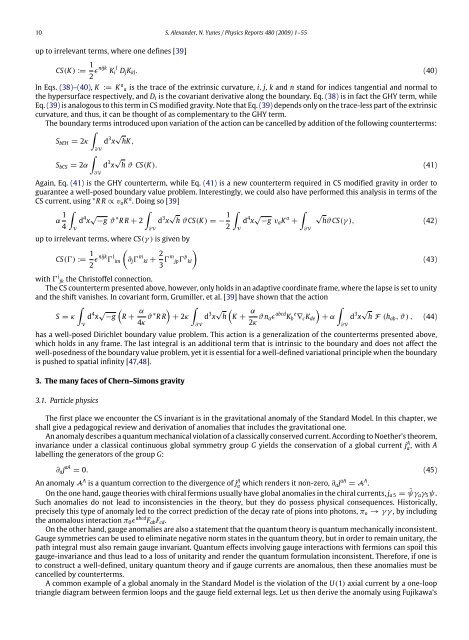Physics Reports ChernâSimons modified general relativity
Physics Reports ChernâSimons modified general relativity
Physics Reports ChernâSimons modified general relativity
You also want an ePaper? Increase the reach of your titles
YUMPU automatically turns print PDFs into web optimized ePapers that Google loves.
10 S. Alexander, N. Yunes / <strong>Physics</strong> <strong>Reports</strong> 480 (2009) 1–55up to irrelevant terms, where one defines [39]CS(K) := 1 2 ɛnijk K i l D j K kl . (40)In Eqs. (38)–(40), K := K a a is the trace of the extrinsic curvature, i, j, k and n stand for indices tangential and normal tothe hypersurface respectively, and D i is the covariant derivative along the boundary. Eq. (38) is in fact the GHY term, whileEq. (39) is analogous to this term in CS <strong>modified</strong> gravity. Note that Eq. (39) depends only on the trace-less part of the extrinsiccurvature, and thus, it can be thought of as complementary to the GHY term.The boundary terms introduced upon variation of the action can be cancelled by addition of the following counterterms:∫√S bEH = 2κ d 3 x hK,∫S bCS = 2α∂V∂V√d 3 x h ϑ CS(K). (41)Again, Eq. (41) is the GHY counterterm, while Eq. (41) is a new counterterm required in CS <strong>modified</strong> gravity in order toguarantee a well-posed boundary value problem. Interestingly, we could also have performed this analysis in terms of theCS current, using ∗ R R ∝ v a K a . Doing so [39]α 1 4∫Vd 4 x √ −g ϑ ∗ R R + 2∫∂V√d 3 x h ϑCS(K) = − 1 2up to irrelevant terms, where CS(γ ) is given byCS(Ɣ) := 1 (2 ɛnijk Ɣ l im ∂ j Ɣ m kl + 2 )3 Ɣm jpƔ p kl∫V√ ∫d 4 x −g v a K a +∂V√hϑCS(γ ), (42)with Ɣ i jk the Christoffel connection.The CS counterterm presented above, however, only holds in an adaptive coordinate frame, where the lapse is set to unityand the shift vanishes. In covariant form, Grumiller, et al. [39] have shown that the action∫S = κVd 4 x √ −g(R + α )4κ ϑ ∗ R R∫+ 2κ∂V√d 3 x h(K + α )2κ ϑn aɛ abcd K e b ∇ c K de + α∫∂V(43)√d 3 x h F (h ab , ϑ) , (44)has a well-posed Dirichlet boundary value problem. This action is a <strong>general</strong>ization of the counterterms presented above,which holds in any frame. The last integral is an additional term that is intrinsic to the boundary and does not affect thewell-posedness of the boundary value problem, yet it is essential for a well-defined variational principle when the boundaryis pushed to spatial infinity [47,48].3. The many faces of Chern–Simons gravity3.1. Particle physicsThe first place we encounter the CS invariant is in the gravitational anomaly of the Standard Model. In this chapter, weshall give a pedagogical review and derivation of anomalies that includes the gravitational one.An anomaly describes a quantum mechanical violation of a classically conserved current. According to Noether’s theorem,invariance under a classical continuous global symmetry group G yields the conservation of a global current j A a , with Alabelling the generators of the group G:∂ a j aA = 0. (45)An anomaly A A is a quantum correction to the divergence of j A a which renders it non-zero, ∂ aj aA = A A .On the one hand, gauge theories with chiral fermions usually have global anomalies in the chiral currents, j a 5 = ¯ψγ a γ 5 ψ.Such anomalies do not lead to inconsistencies in the theory, but they do possess physical consequences. Historically,precisely this type of anomaly led to the correct prediction of the decay rate of pions into photons, π o → γ γ , by includingthe anomalous interaction π 0 ɛ abcd F ab F cd .On the other hand, gauge anomalies are also a statement that the quantum theory is quantum mechanically inconsistent.Gauge symmetries can be used to eliminate negative norm states in the quantum theory, but in order to remain unitary, thepath integral must also remain gauge invariant. Quantum effects involving gauge interactions with fermions can spoil thisgauge-invariance and thus lead to a loss of unitarity and render the quantum formulation inconsistent. Therefore, if one isto construct a well-defined, unitary quantum theory and if gauge currents are anomalous, then these anomalies must becancelled by counterterms.A common example of a global anomaly in the Standard Model is the violation of the U(1) axial current by a one-looptriangle diagram between fermion loops and the gauge field external legs. Let us then derive the anomaly using Fujikawa’s



![arXiv:1001.0993v1 [hep-ph] 6 Jan 2010](https://img.yumpu.com/51282177/1/190x245/arxiv10010993v1-hep-ph-6-jan-2010.jpg?quality=85)


![arXiv:1008.3907v2 [astro-ph.CO] 1 Nov 2011](https://img.yumpu.com/48909562/1/190x245/arxiv10083907v2-astro-phco-1-nov-2011.jpg?quality=85)







![arXiv:1002.4928v1 [gr-qc] 26 Feb 2010](https://img.yumpu.com/41209516/1/190x245/arxiv10024928v1-gr-qc-26-feb-2010.jpg?quality=85)
![arXiv:1206.2653v1 [astro-ph.CO] 12 Jun 2012](https://img.yumpu.com/39510078/1/190x245/arxiv12062653v1-astro-phco-12-jun-2012.jpg?quality=85)
